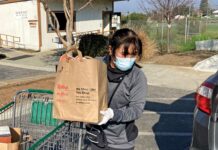Biointensive gardening: It’s a new-fangled thing that isn’t so
new. In fact, the practice dates back to ancient gardening
techniques that were perfected in the 1960s, but it is thought by
some to be the perfect method for home gardening.
Biointensive gardening: It’s a new-fangled thing that isn’t so new. In fact, the practice dates back to ancient gardening techniques that were perfected in the 1960s, but it is thought by some to be the perfect method for home gardening.
“Biointensive gardening is a technique of producing more on less ground,” said Orin Martin, manager of the Chadwick Garden at University of California, Santa Cruz. “Also, if you have bad soil, using this method will improve it.”
The Chadwick Garden is named for Alan Chadwick, the English master horticulturist and Ecology Hall of Famer, who perfected the techniques of ancient Chinese, Greek and French agriculture and then put them into practice on the two acres of land at UCSC in 1967. Chadwick’s refined techniques are what is now called “biointensive gardening.”
Biointensive gardening is the method of using organic materials and specific growing methods to produce an abundance of plants in a small area. The method is used to grow food and ornamental plants.
John Jeavons, executive director of agricultural and research and development group Ecology Action, says the method has proven itself repeatedly in 130 different countries and in a variety of climates. Biointensive gardening has been particularly effective in countries where food production has traditionally been difficult, Jeavons said.
“I think it’s especially feasible for home gardens, because you can get two to six times the yield of conventional gardening and use three to eight times less water per pound of food produced,” he said.
According to Ecology Action, the basics of biointensive gardening for the home gardener are:
Deep-dug soil
Crops and flowers are planted in beds of soil that have been dug up, churned and loosened down to 2 feet. This allows more air into the soil and facilitates better water movement.
Composting
Using organic composting keeps the soil and plants healthy by not depleting the soil’s nutrients, which can happen with some chemical fertilizers.
“Get a mature and finished compost, not raw,” Martin said.
Intensive Planting
Seeds or seedlings should be planted close together in 3-by-5-foot-wide beds in a hexagonal spacing pattern. The plants should all be placed the same distance apart so when they mature, their leaves gently touch. However, avoid overcrowding them, or you risk stunting their growth.
Companion Planting
Some plants grow better when planted with certain other plants, such as green beans grown near strawberries. Carrots and radishes thrive well together, tall plants often go well with short plants, and slow-growing plants do well with fast-growing ones.
Complete System
Ideally, all the aspects of biointensive growing should work together. Using only a few pieces of the system isn’t enough.
If you’re using the technique strictly for food and not for aesthetic purposes – such as for flowers or decorative plants – Ecology Action has two additional steps on its Web site.
The first thing home gardeners should do before putting the biointensive system in place is assess their soil, Martin said, and the second is determining how deep you should dig. If you already have good soil, you may not need to do as much deep digging. Conversely, if you have particularly bad soil, you’ll have to be more concerned about deep digging.
“At least initially, it’s a very high-labor system,” Martin said. “But it really pays off in a short period of years, and the labor becomes less and less intense.”
But Jeavons disagrees that biointensive gardening is labor intensive.
“You only need a quarter of the area, so you’re weeding a smaller area, purchasing nutrients for a small area and you’re working a smaller area,” he said. “It’s a really good deal.”
Once a biointensive system is in place, however, the work isn’t over.
“You need to have some gardening knowledge to actually grow the plants, but this system sets the stage very nicely,” Martin said.
Resources for Biointensive Gardeners
Tips on biointensive gardening and how to assess your soil (aside from having a professional come to your home) are available at “Teaching Organic Farming and Gardening: Resources for Instructors,” a guide from the University of California, Santa Cruz. The site is http://zzyx.ucsc.edu/casfs/instruction/tofg/index.html.
Ecology Action has two Web sites:
www.growbiointensive.org contains information about weekend workshops, and
www.commongroundinpaloalto.org contains information about classes held on Saturdays.
The organization also has a book called “How to Grow More Vegetables, Fruit, Nuts, Berries, Grains and Other Crops Than You Ever Thought Possible on Less Land Than You Can Imagine.” The book, in its sixth edition, has been translated into eight languages, including Braille.













